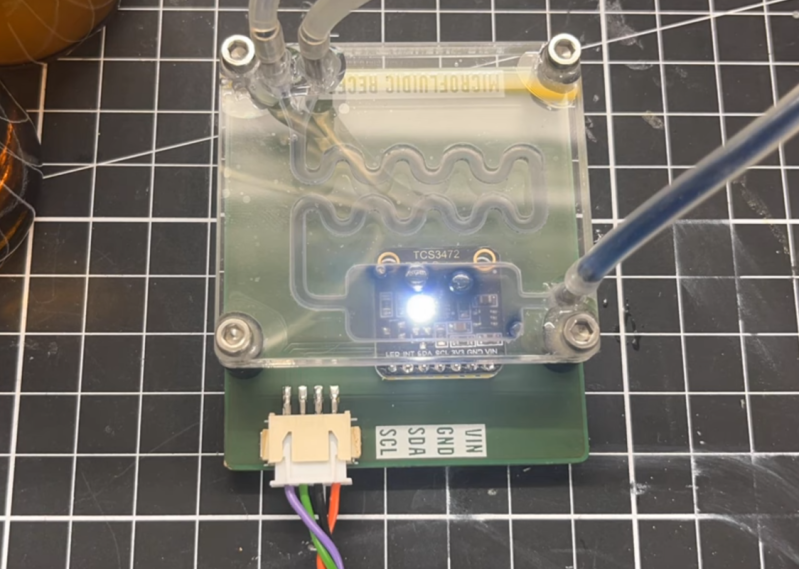While advances in modern technology have allowed average people access to tremendous computing power as well as novel tools like 3D printers and laser cutters for a bare minimum cost, around here we tend to overlook some of the areas that have taken advantage of these trends as well. Specifically in the area of chemistry, the accessibility of these things have opened up a wide range of possibilities for those immersed in this world, and [Marb’s Lab] shows us how to build a glucose-detection lab in an incredibly small form factor.
The key to the build is a set of three laser-cut acrylic sheets, which when sandwiched together provide a path for the fluid to flow as well as a chamber that will be monitored by electronic optical sensors. The fluid is pumped through the circuit by a custom-built syringe pump driven by a linear actuator, and when the chamber is filled the reaction can begin. In this case, if the fluid contains glucose it will turn blue, which is detected by the microcontroller’s sensors. The color value is then displayed on a small screen mounted to the PCB, allowing the experimenter to take quick readings.
Chemistry labs like this aren’t limited to one specific reaction, though. The acrylic plates are straightforward to laser cut, so other forms can be made quickly. [Marb’s Lab] also made the syringe pump a standalone system, so it can be quickly moved or duplicated for use in other experiments as well. If you want to take your chemistry lab to the extreme, you can even build your own mass spectrometer.
















Anyone know where the design files or more information on this can be found?
Make sure the references are current.
https://www.earth.com/news/100-year-old-chemistry-rule-bredts-rule-proven-false-updating-textbooks-comes-next/
Repeat after me, “ACRYLIC IS A PLASTIC, NOT A GLASS”!
Just finished watching the video, very thought out and well done project that is very cost effective. Kudos all around.
This seems like they’re using the form of the word glass that is used like an adjective in describing things that are similar to the noun form of glass. For example I’m sure you’ve heard of safety glass. And I’m sure you’ve also heard of things being described as glassy.
Furthermore, it should be fairly obvious from the context that the individual involved has enough understanding of science to know that acrylic is not glass, and therefore was using it as a description of acrylic rather than saying it was actual glass. So the all caps you used seems to demonstrate that maybe you missed this point or forgot that you knew the word can be used as a descriptor.
But regardless, language evolves, and unless you’re dealing with a rigorously precise system like mathematics in which the definitions and language are significantly more fixed, language that is used to describe science on the internet should most definitely be more colloquially based to help improve science communication to the lay world.
And here I was hoping Waldo was referring to the chemical properties of acrylic and why glass is used in labs instead
PMMA is widly used for microfludic devices: https://www.plexiglas.de/files/plexiglas-content/pdf/technische-informationen/319-2-PLEXIGLAS-and-EUROPLEX-COC-Films-for-microfluidic-applications.pdf
PMMA is a non-crystalline amorphous solid, a.k.a. a glass.
Isn’t it a glass, as in not a crystal.
They should mash this up with the lego mindstorm syringe pump from https://www.nature.com/articles/s41467-019-09231-9
Can anyone find derails or design files for this build? The video seems to lack details needed to replicate and extend this work.
I worked for Agilent Technologies in the early 2000’s. We worked on DNA chip technology at that time. Some scientists and engineers worked on developing micro-fluidics for micro labs to reduce the sample and reagents amounts. Very similar to what is described above.